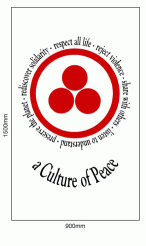Banner Of Peace
Banner of Peace – Manifesto 2000
A Culture of Peace Banner featuring the Banner of Peace and Manifesto 2000 has been created by Peace Through Unity. Institutions concerned with education (from kindergartens to universities), places of worship and cultural significance, local and central governments etc. are invited to display the banner as a visible symbol of their commitment to a Culture of Peace.

Creating a Culture of Peace
Culture is and has always been at the very heart of the life of humanity – of every tribe, nation and civilization. Through Culture we have ever been striving to express the fullness of our being and to interpret our relationships to each other, to the environment, to nature, to God.
Through religion, the arts and science humanity has sought ever deeper understanding of the universe and the role we are to play within this wondrous and continuously evolving whole.
We live in a world today, which is very far from the world we wish for ourselves and our children. We are challenged to restore culture to its rightful place in our own lives and in our society – a culture which respects all cultures and reveres and celebrates life in all its many forms as well as the Giver of Life. A Culture of Peace.
Banner of Peace
In the beginning of the 20th Century the great Russian artist, scientist and philosopher, Nicholas Roerich (1894 to 1947), was inspired by the concept of a “peace through culture”. His greatest concern was that warfare led to the devastation and vandalism of the “creations of human genius” — not just buildings and cultural sites, the arts and history but also the living knowledge and the beauty of the spirit of peoples everywhere. With this in mind he created a special Banner of Peace and the “Roerich Pact” to signify the protection of all these cultural treasures.
Nicholas Roerich hoped that the Banner of Peace would be flown throughout the world as a sign of neutrality and of the commitment to peaceful co-existence between all peoples. The symbol on the Banner , three circles within a sphere — the sign of the trinity — has been used from the dawn of human history by cultures throughout the world and therefore belongs to all humanity.
The Roerich Pact is an agreement between signature states to respect and protect the neutrality of all educational, artistic and scientific institutions. The Pact was signed by the governments of many nations, including the United States (in 1934) and every member state of the Pan-American Union. Franklin D, Roosevelt, referring to the Roerich Pact said: “This treaty possesses a spiritual significance far deeper than the text of the instrument itself”.
Manifesto 2000
Towards the end of the same century the concept of a culture of peace was gaining strength. Nobel Peace Laureates met together and drew up six simple guidelines which they believed – if followed – would help build a culture of peace: “respect all life; reject violence; share with others; listen to understand; preserve the planet; rediscover solidarity”. These Guidlines and an associated pledge became known as Manifesto 2000. The Manifesto forms the basis for UNESCO’s campaign for a culture of peace and has to date been signed by more than 75 million people.
Linking the Banner of Peace & Manifesto 2000
The United Nations General Assembly’s Declaration and Programme for Action on a Culture of Peace urges that all UN member nations cooperate with their peoples in creating together a culture of peace. Peace Through Unity proposes that the symbol from the banner of peace encircled by the six point guidelines from Manifesto 2000 forms a perfect logo symbolizing the cooperation between peoples and governments in the creation of a culture of peace.
The Banner

All weather banners with an aluminium pole at the top and hanging cord, measuring 1500 x 900mm (59 x 35 inches)are available at cost. These banners make a beautiful display in any house, school, institution or office – they can also be used in sanctuaries, centres and shrine rooms. They make wonderful focal points for gatherings, rituals, ceremonies and special occasions.
Using the Banner — A proposal
With the Manifesto 2000 guidelines characterizing our many different endeavours to create a better world, and the Banner of Peace symbolizing the goal we have in common, Peace Through Unity proposes that institutions concerned with education (from kindergartens to universities), places of worship and cultural significance, local and central governments etc:
- Be informed of the Banner of Peace and the Manifesto 2000;
- Be encouraged to make a commitment to promoting through their particular work in every possible way the emergence of a culture of peace;
- Display the Banner and the Manifesto as a visible symbol of their commitment to a Culture of Peace.
- Sign the following pledge:
I/we hereby resolve to promote actively, consistently, and in every way possible the creation of a culture of peace, built upon the foundation of right human relations and the realisation of the basic oneness of all life.
In accordance with Manifesto 2000, I/we make the solemn pledge to: respect all life; reject violence; share with others; listen to understand; preserve the planet; rediscover solidarity.
May the Banner of Peace and the Manifesto 2000 help guide our way into the New Era.
